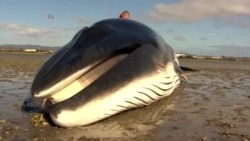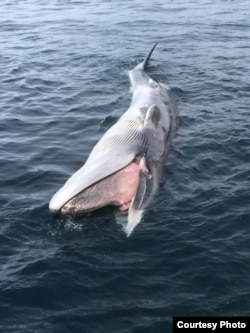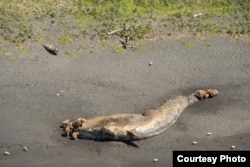While President Barack Obama is in Alaska, he might have this question: Why have 30 dead whales washed ashore from the Gulf of Alaska since May?
Scientists with the National Oceanic and Atmospheric Administration have mobilized a research team to find out. NOAA marine scientist Deborah Fauquier said that on average,only eight whale carcasses are found per year. “It was definitely elevated, and for us it was a reason of concern,” she said.
Fauquier said the “unusual mortality event” was complicated and that scientists were considering a range of factors, including disease, predation, starvation, ship strikes and harmful algae.
While most algae are safe, the less common toxic variety can cause brain damage or death. The largest such bloom in more than a decade appeared in June along the Pacific Coast from California to Alaska, in part because of warm water and sunny, calm weather. The blooms had some of highest concentrations of the natural toxin domoic acid ever observed in Monterrey Bay and off the central Oregon coast, according to NOAA's Northwest Fisheries Science Center.
Fisheries in several states were forced to close.
“We’re taking advantage of our active surveys to focus research on a serious concern for coastal communities and the seafood industry,” said Eileen Sobeck, assistant administrator for NOAA fisheries. “The better we understand what’s happening out on the water, the better we can address the impacts.”
Fauquier noted that in the ocean, toxins move up the food chain. “Some of the whales actually filter the phytoplankton and the zooplankton, which are the little insects that eat the grass in the sea. So, they get the toxins through that method. The other one is that they eat the fish that eat those. So it just depends where on the food web they eat, and as you go higher up the food web, more toxin gets concentrated.”
The waters around Alaska are warming, a trend that began in 2014 and continues today with temperatures 3 degrees Celsius above normal. Scientists say the warming is due to an El Nino weather event and wind patterns, and is not linked to climate change.
But global emissions are warming the planet, heating the Arctic faster than anywhere else. At the beginning of the latest melt season, Arctic sea ice was at its lowest level on record, a problem for polar bears, walruses and other marine mammals that use sea ice as a platform on which to hunt, live and breed.
Fauquier said the ocean is a dynamic system affected by rising temperatures. “For Arctic species, species that normally like cold water, it is going to change the phytoplankton, so it’s going to change the base of the food web. It is going to change the fish. They may go farther north because they don’t like warm water, and so the predators that are mobile are either going to have to follow those fish or, if they can’t follow them, then they can starve."
Fauquier said NOAA hopes to explain why the whales died and why they perished in such great numbers. Knowing the cause, she said, is the first step to understanding the problem.









